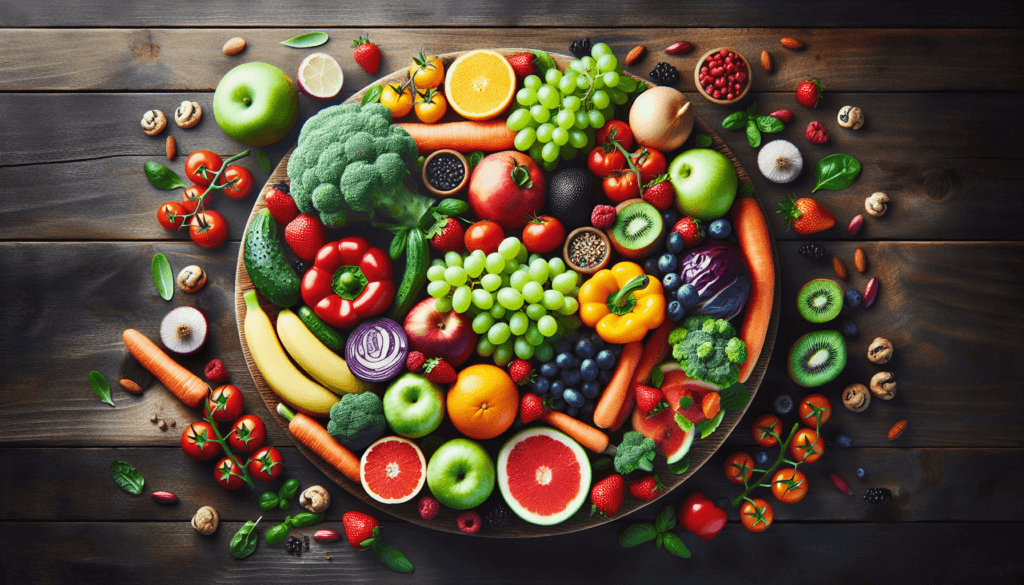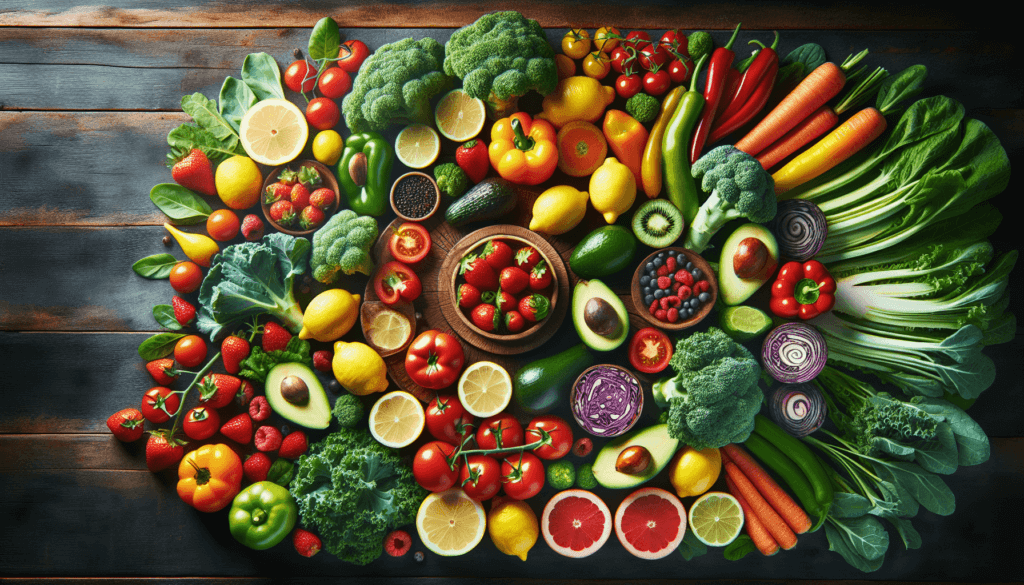You’re always looking for new ways to maintain a healthy lifestyle, and one important aspect of that is the food you consume. In this article, you’ll find the most popular cooking tips for healthy eating that will help you make nutritious meals without sacrificing flavor. Whether you’re a seasoned chef or just starting out in the kitchen, these tips will provide you with practical advice to create delicious dishes that are good for your body. So grab your apron and get ready to revolutionize your cooking techniques for a healthier you!
Meal Planning
Plan your meals in advance
Meal planning is a crucial aspect of maintaining a healthy diet. By taking the time to plan your meals in advance, you ensure that you have nutritious options readily available and can avoid last-minute unhealthy food choices. Sit down and create a weekly meal plan, considering your schedule and dietary goals. Planning ahead allows you to incorporate a variety of nutritious ingredients and ensures that you have all the necessary ingredients on hand when it’s time to cook.
Include a variety of nutritious ingredients
When planning your meals, it’s essential to include a wide range of nutritious ingredients. Aim for a balanced combination of lean proteins, whole grains, fruits, vegetables, and healthy fats. By incorporating a variety of ingredients, you not only provide your body with essential nutrients but also add flavor and excitement to your meals. Experiment with different flavors, textures, and cooking techniques to keep your meals interesting and enjoyable.
Consider portion sizes
While including nutritious ingredients in your meals is important, it’s equally crucial to be mindful of portion sizes. Even healthy foods can contribute to weight gain if consumed in excessive quantities. Use measuring cups or a food scale to ensure you’re serving appropriate portion sizes. Additionally, try to fill your plate with a larger proportion of vegetables and lean proteins, while keeping starchy carbohydrates and fats in moderation. By being conscious of portion sizes, you can maintain a healthy weight and prevent overeating.
Healthy Substitutions
Replace butter with healthier alternatives
Butter is a staple ingredient in many dishes, but it can be high in saturated fats. To make your meals healthier, try substituting butter with healthier alternatives. Options like olive oil, coconut oil, or avocado oil can provide a similar richness while offering beneficial monounsaturated fats. These healthier fats can have a positive impact on heart health and cholesterol levels.
Use herbs and spices instead of salt
Salt is often used in cooking to enhance flavor, but excessive sodium intake can contribute to high blood pressure. An alternative to using excessive salt is to incorporate herbs and spices into your cooking. Not only do they add an array of flavors, but they also come with their own health benefits. For example, cinnamon has been shown to help regulate blood sugar levels, while turmeric has anti-inflammatory properties. Experiment with different herbs and spices to discover exciting and nutritious flavor combinations.
Choose whole grain options
When it comes to carbohydrates, opt for whole grains instead of refined options. Whole grains provide more fiber, vitamins, and minerals than their refined counterparts. Instead of white rice, try brown rice or quinoa. Swap out refined pasta for whole wheat or legume-based alternatives. By choosing whole grains, you’ll increase your intake of essential nutrients while also promoting better digestion and overall health.

Cooking Methods
Steam or bake instead of frying
Frying food in oil can add unnecessary calories and increase the intake of unhealthy fats. To keep your meals healthy, consider using alternative cooking methods such as steaming or baking. Steaming your food helps preserve nutrients while maintaining a delicious taste and texture. Baking is another excellent option that requires little to no added oil. It allows the natural flavors of the ingredients to shine while still achieving a satisfying and indulgent result.
Grill or broil meats instead of frying or sautéing
When cooking meats, it’s best to avoid frying or sautéing in excessive amounts of oil. Instead, consider grilling or broiling your meats. Grilling not only adds a smoky and unique flavor to the meat but also allows excess fat to drip away, reducing calorie and fat content. Broiling is a cooking method that uses high heat from above, resulting in a flavorful and nicely browned exterior, while keeping the interior tender and juicy.
Use non-stick cookware to reduce the need for oil
Using non-stick cookware is a simple yet effective way to reduce the amount of oil needed in cooking. With non-stick pans, you can achieve the desired cooking results without the need for excessive oil. This not only cuts down on the amount of unhealthy fats consumed but also makes the cooking process easier and less messy. The non-stick surface allows ingredients to be easily released, ensuring that your food retains its natural flavors while still achieving a beautiful texture.
Vegetable Preparation
Wash vegetables thoroughly before using
Before preparing your vegetables, make sure to wash them thoroughly. Washing vegetables helps remove dirt, bacteria, and any residue that may be present on the surface. Even if the vegetable will be peeled or cooked, it’s important to start with clean produce to prevent cross-contamination and to ensure the highest level of food safety. Use running water and a vegetable brush to gently scrub the vegetables, and then pat them dry before cutting or cooking.
Cut vegetables into uniform sizes for even cooking
To ensure that your vegetables cook evenly, it’s important to cut them into uniform sizes. By doing so, all pieces will cook at the same rate, resulting in a perfectly cooked, tender, and delicious dish. Aim for consistent thickness and shape when slicing or dicing. This is particularly important when stir-frying or roasting vegetables, as it allows them to cook evenly and caramelizes their surfaces uniformly.
Try different cooking techniques for different vegetables
Not all vegetables are created equal, and they each respond differently to different cooking techniques. Some vegetables, like carrots and potatoes, benefit from roasting, which brings out their natural sweetness and adds texture. Others, like leafy greens, are best suited for steaming or sautéing, as these methods help retain their vibrant color and delicate texture. By experimenting with various cooking techniques, you can discover the best way to highlight the flavors and textures of each vegetable.

Protein Sources
Choose lean protein options
Protein is an essential nutrient that plays a crucial role in various bodily functions. When selecting protein sources, opt for lean options to minimize saturated fat intake. Lean proteins include skinless chicken breast, fish, tofu, beans, and lentils. These choices can provide the necessary protein your body needs while being lower in fats. By choosing lean proteins, you promote heart health, support muscle growth and repair, and maintain a healthy weight.
Include plant-based protein sources
Plant-based protein sources offer numerous health benefits and are an excellent addition to a well-rounded diet. Foods like quinoa, chickpeas, black beans, and edamame provide a good amount of protein while also offering fiber, vitamins, and minerals. Incorporating plant-based proteins into your meals is not only beneficial for your health but also for the environment. It helps reduce the carbon footprint associated with meat production and contributes to a more sustainable food system.
Explore different ways to prepare proteins
To keep your meals interesting and avoid taste fatigue, experiment with different ways of preparing proteins. For example, marinating chicken or tofu in a flavorful sauce can add depth to the final dish. Grilling fish with a squeeze of lemon or seasoning it with fresh herbs can elevate the flavor profile. Trying new cooking methods or flavor combinations can help you discover exciting ways to enjoy your protein sources while keeping your meals healthy and satisfying.
Healthy Fats
Incorporate sources of healthy fats into your meals
Contrary to popular belief, fats are an essential part of a healthy diet. However, it’s crucial to distinguish between unhealthy fats, such as saturated and trans fats, and healthy fats, such as monounsaturated and polyunsaturated fats. While keeping unhealthy fats in moderation, it’s important to incorporate sources of healthy fats into your meals. Avocados, nuts, seeds, and olive oil are excellent examples of foods that provide beneficial fats and contribute to heart health and overall well-being.
Limit the use of unhealthy fats
Unhealthy fats, such as saturated fats and trans fats, can raise cholesterol levels and increase the risk of heart disease. It’s important to limit the consumption of these fats as much as possible. Avoid foods like fried foods, processed snacks, and baked goods that are often high in saturated and trans fats. By making conscious choices and opting for healthier alternatives, you can reduce the negative impacts of unhealthy fats on your health.
Read labels to identify sources of trans fats
Trans fats are particularly harmful to our health and can be found in many processed and packaged foods. To avoid consuming trans fats, it’s essential to read food labels carefully. Look for keywords like “partially hydrogenated oils” on the ingredient list, as this is an indicator of trans fats being present. By being vigilant and informed, you can make healthier food choices and prioritize your well-being.

Reducing Added Sugar
Use natural sweeteners instead of refined sugars
Added sugar can contribute to weight gain, affect blood sugar levels, and increase the risk of chronic diseases. When sweetening your meals or beverages, opt for natural sweeteners instead of refined sugars. Choices like honey, maple syrup, or dates provide sweetness and flavor while also offering some additional nutrients. By using natural sweeteners, you can satisfy your sweet tooth without compromising your health.
Gradually reduce the amount of sugar in your recipes
If you’re used to consuming a lot of added sugar, it may be challenging to make the switch to a lower-sugar diet overnight. To make the transition easier, try gradually reducing the amount of sugar in your recipes. Start by cutting the recommended amount by 25%, and continue decreasing it over time. Your taste buds will adapt, and you’ll find that you can still enjoy delicious meals with less added sugar.
Be mindful of hidden sugars in packaged foods
Added sugars can hide in unexpected places, such as condiments, salad dressings, and even savory snacks. When shopping for packaged foods, make it a habit to read the ingredient labels carefully. Look out for sources of hidden sugars like high-fructose corn syrup, dextrose, or maltose. By being aware of the hidden sugars in your favorite packaged foods, you can make informed choices and prioritize your health.
Food Storage
Properly store fresh produce to maintain their freshness
To maximize the shelf life and maintain the freshness of your fresh produce, it’s important to store them properly. Different fruits and vegetables have varying storage requirements. For example, leafy greens should be washed, dried thoroughly, and stored in a sealed container with a paper towel to absorb excess moisture. By understanding the specific storage needs of each fruit and vegetable, you can prevent premature spoilage and food waste.
Label and date leftovers to avoid food waste
To avoid food waste and ensure the safety of your leftovers, it’s crucial to label and date them properly. Use containers with clear lids or labels to indicate the contents and the date of storage. This way, you can easily keep track of when each item was prepared and make sure you consume them within a safe timeframe. By utilizing leftovers efficiently, you can save money, reduce food waste, and maintain a healthy eating routine.
Invest in storage containers for meal prep and leftovers
Investing in quality storage containers is a wise choice when it comes to meal planning and food storage. Look for containers that are reusable, durable, and leak-proof. This will allow you to store prepared meals, leftovers, or pre-cut vegetables safely and conveniently. Having a variety of container sizes on hand ensures that you can store any quantity of food properly and keep your refrigerator organized.

Cooking for Special Diets
Research recipes and techniques specific to dietary restrictions
If you have specific dietary restrictions or are cooking for someone who does, it’s important to research recipes and techniques tailored to those needs. Whether it’s gluten-free, vegan, or low-sodium, there are countless resources available that offer delicious and nutritious recipes to accommodate special diets. By familiarizing yourself with these recipes and techniques, you can create meals that are both satisfying and compliant with dietary restrictions.
Experiment with alternative ingredients for allergen-free meals
Cooking for individuals with food allergies or sensitivities may require substituting certain ingredients. Experimenting with alternative ingredients that are free of common allergens can help you create meals that cater to everyone’s needs. For example, replacing dairy milk with nut milk or using gluten-free flour instead of wheat flour. With a bit of creativity and exploration, you can ensure that everyone at the table can enjoy a safe and delicious meal.
Consult with a nutritionist or dietitian for personalized guidance
If you’re unsure about how to navigate a specific dietary restriction or have questions about healthy cooking, it’s always beneficial to seek the guidance of a nutritionist or dietitian. These professionals can provide personalized advice, recommend suitable recipes and techniques, and help you plan meals that align with your dietary goals. They have the expertise to guide you through any potential challenges and ensure that your meals are both healthy and enjoyable.
Mindful Eating
Practice portion control and listen to your body’s hunger and fullness cues
Mindful eating involves being fully present during meals and paying attention to your body’s hunger and fullness cues. By practicing portion control and listening to your body’s signals, you can avoid overeating and promote a healthier relationship with food. Eat slowly and savor each bite, allowing yourself to fully enjoy the flavors and textures. By being mindful and present, you’ll develop a greater appreciation for your meals and gain better control over your eating habits.
Savor the flavors and textures of your food
Food is not just fuel for our bodies; it’s an experience to be savored and enjoyed. Take the time to appreciate the flavors, aromas, and textures of your food. Engage all your senses while eating, and try to fully immerse yourself in the experience. Whether it’s relishing the creaminess of avocado, the crunchiness of a fresh apple, or the richness of dark chocolate, every bite can be a moment of pleasure and satisfaction.
Avoid distractions while eating to fully enjoy and appreciate your meal
To practice mindful eating, it’s important to avoid distractions during mealtime. Turn off the TV, put away your phone, and create a calm and peaceful dining environment. By eliminating distractions, you can focus on your food, savor each bite, and be fully present in the experience. This not only enhances your enjoyment of the meal but also allows you to tune in to your body’s signals of hunger and fullness more effectively.
Incorporating healthy cooking tips into your daily routine can have a significant impact on your overall well-being. By planning your meals in advance, choosing nutritious ingredients, and opting for healthier cooking methods, you can create delicious and satisfying meals while prioritizing your health. Remember to explore different flavors, textures, and cooking techniques, and don’t be afraid to experiment with new ingredients. By being mindful of portion sizes, reducing added sugars, and practicing mindful eating, you can develop healthier habits and enjoy the journey to a nourished and balanced lifestyle.



